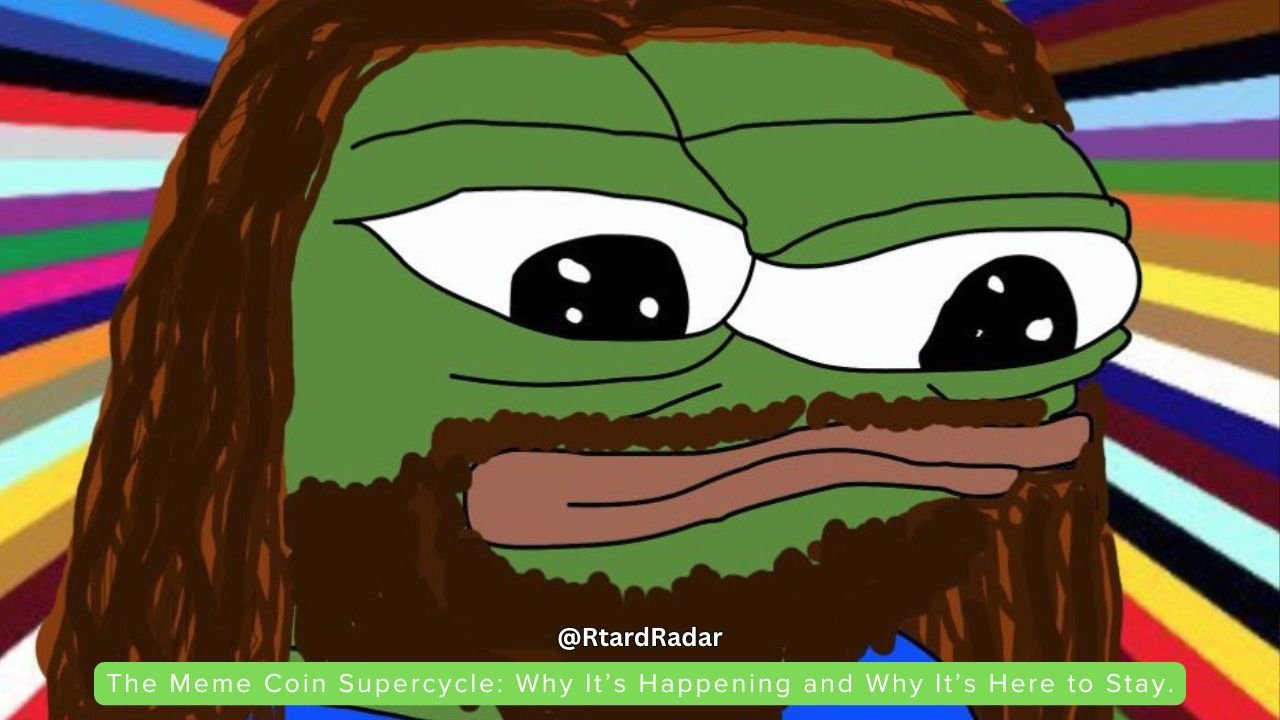
The meme coin supercycle isn’t just a speculative forecast—it’s a reality unfolding in 2024. Meme coins are outperforming nearly every other crypto asset class, signaling a seismic shift in the crypto market. In this comprehensive exploration, Murad unpacks why this supercycle is happening, the internal and external forces driving it, and why meme coins are poised to dominate in 2025 and beyond. This article is divided into four parts to cover the full scope of Murad’s argument:
-
The Rise of Meme Coins: A Market in Transition
-
Internal Drivers: The Broken Altcoin Ecosystem
-
External Drivers: A World Fueling Meme Coin Mania
-
The Future: Meme Coins as Tokenized Communities and Predictions for 2025
Part 1: The Rise of Meme Coins: A Market in Transition
The crypto market of 2024 is a mixed bag. While many asset categories have disappointed investors with lackluster performance, meme coins have emerged as the standout performers. Murad highlights that year-to-date data shows both old meme coins (like Dogecoin and Shiba Inu) and new ones (like WIF and Pepe) dominating in terms of outperformance. This isn’t a temporary spike—it’s a structural shift in how the crypto market operates.
The era of all crypto assets rising in unison is over. The once-popular sentiment of “we’re all gonna make it” has been replaced by a more selective market dynamic. Murad notes that, if you examine the first three pages of CoinMarketCap, only 43 tokens have outperformed Bitcoin year-to-date, and a remarkable 13 of the top 20 are meme coins. This dominance signals a natural evolution in the crypto space, where retail investors are gravitating toward assets that resonate emotionally and financially.
Murad emphasizes that the meme coin supercycle is already underway, not just a prediction. Meme coins are capturing attention and capital at an unprecedented rate, driven by their simplicity, accessibility, and ability to create passionate communities. But why are meme coins outperforming while other categories struggle? The answer lies in a combination of internal crypto market dynamics and external societal trends.
Part 2: Internal Drivers: The Broken Altcoin Ecosystem
The meteoric rise of meme coins is partly a reaction to the flaws in the altcoin ecosystem. Murad outlines several internal factors that expose the inefficiencies and inequities of tech-focused altcoins, making meme coins a more attractive alternative for retail investors.
1. Token Overproduction and Inflated Valuations
In 2024, the crypto market saw an explosion of new tokens—over 600,000 launched by April, with more than 5,500 new tokens flooding the market daily. Murad explains that this overproduction has led to inflated altcoin valuations, particularly at centralized exchange listings. The process is rigged against retail investors:
-
Insider Advantage: Founders receive tokens at zero cost, while venture capitalists (VCs), angel investors, and centralized exchanges secure large portions at steep discounts. Market makers, Twitter influencers, Telegram callers, and YouTubers are often paid in tokens or dollars to hype the project.
-
Retail as Exit Liquidity: By the time a token lists at a $5–15 billion valuation, retail investors buy in at peak prices, only to face inevitable dumps as insiders cash out. Murad notes that retail is consistently left holding the bag, unable to benefit from the price appreciation that occurs in private rounds.
2. Deliberate Overvaluation
Murad argues that altcoins are deliberately listed at inflated valuations to ensure insider profits even after significant price crashes. For example, a token listed at a $10 billion valuation may drop 90%, but seed investors—who bought in at pennies—still walk away with 100x returns. Retail investors, misled into thinking the post-crash price is a bargain, are trapped in a losing position. This pattern is evident in 2024 Binance launches, where nearly every token has been “down only” since listing, with two exceptions: WIF (barely up) and Jupiter, a meme coin trading infrastructure.
3. Lack of Sustainable Utility
Despite a decade of smart contracts, few altcoins offer non-speculative utility. Murad points out that even the most successful decentralized applications (dApps)—like Uniswap, Pump.fun, Polymarket, Jupiter, and Blur—are deeply tied to speculation. These are among the highest product-market-fit (PMF) products in crypto history, yet they rely on trading and gambling rather than sustainable revenue streams.
Many altcoins generate negligible fees—some as low as $500/day—while trading at $5–10 billion valuations. Murad highlights that these projects often cite regulatory barriers as a reason for not sharing revenue with token holders, but the real issue is that revenue-sharing would expose their overvaluation. If valued like traditional assets in a spreadsheet, most altcoins would be deemed 100x overpriced, relying on narrative and “mimetic premium” to sustain their market caps.
4. Massive Token Unlocks
Murad cites Binance Research, which projects $155 billion in token unlocks over the next five years, creating a significant headwind for tech altcoins. These unlocks dilute supply and depress prices, discouraging retail investment. In contrast, meme coins like Dogecoin, Shiba Inu, Pepe, and WIF are fully circulating with no unlocks, making them more predictable and appealing to retail.
5. Community and Organic Growth
Murad contrasts the insider-heavy distribution of altcoins with the organic, community-driven nature of meme coins. Many altcoin launches allocate 80% of the supply to insiders, alienating retail and stifling community growth. Meme coins, on the other hand, enable retail investors to buy in early at low prices, fostering decentralized ownership. This creates a virtuous cycle where early holders become “poor hodlers” who get rich and transform into unpaid evangelists, tirelessly promoting the project.
Murad cites examples like Dogecoin, Shiba Inu, Pepe, and WIF, which have reached $50–100 billion valuations, proving to the market that meme coins can achieve massive scale. These successes have awakened retail investors to the idea that the token itself—not the software—is the real product in crypto. Murad argues that the industry is a “token production industry masquerading as a software production industry.”
6. The Failure of Revenue-Driven Tokens
Even altcoins touted as legitimate revenue producers—like those in DeFi or infrastructure—have underperformed in 2024. Murad notes that the exceptions are Banana (used for meme coin trading) and Aave (boosted by Base’s meme coin season). He explains that revenue creates a floor for token value but also a ceiling, as investors can more easily calculate overvaluation. Meme coins, unburdened by revenue expectations, have no such ceiling, allowing their prices to soar on narrative and momentum alone.
Part 3: External Drivers: A World Fueling Meme Coin Mania
While internal market dynamics set the stage, external societal trends are supercharging the meme coin supercycle. Murad paints a picture of a world in crisis, where retail investors are turning to meme coins for financial opportunity and emotional connection.
1. Economic and Social Pressures
Murad describes a world facing significant challenges:
-
Inflation and Inequality: Rampant inflation, skyrocketing prices for everyday goods, and growing wealth and income inequality are squeezing retail investors, particularly young people.
-
Job Disruption: AI is threatening traditional career paths, including STEM and computer science degrees, leaving fewer perceived ways to “make it.”
-
Global Disparities: Conditions are even worse outside the developed world, where economic opportunities are scarce.
2. A Crisis of Meaning
Murad identifies social trends compounding these economic challenges:
-
Loneliness and Mental Health: Accelerating loneliness, sexlessness, and mental health issues are creating a void in people’s lives.
-
Declining Religion: The diminishing influence of religion has left a gap in identity, purpose, and community.
-
Digital Overload: People are spending more time online, where attention is currency and hyper-competitive environments dominate.
3. Retail Motivations
Murad emphasizes that retail investors don’t care about technical details like blockchain privacy, speed, or zero-knowledge proofs (ZK-snarks). Instead, they’re driven by three core desires:
-
Making Money: The potential for life-changing gains.
-
Having Fun: The entertainment and excitement of participating in a vibrant community.
-
Belonging: A sense of identity and connection in a fragmented world.
Meme coins excel at meeting these needs, offering a financialized escape from societal pressures and a chance to join a movement.
4. Stories and Momentum
Murad stresses the power of stories in driving trends. Viral tales of massive gains—seen in coins like Pepe, Bonk, and WIF—spread through Phantom wallet screenshots and social media, fueling retail inflows. Historical cycles show that momentum is key: assets that outperform in the first half of a cycle (like Ethereum in 2016, Verge in 2016, or Solana in 2020) often continue to dominate in the second half. Murad believes the “meme mania” of March 2024 was just the first of three anticipated pumps, with two larger waves expected in 2025.
5. The Cultural Void
Meme coins are filling a cultural void left by declining institutions. Murad compares them to video games, music festivals, CrossFit, or even Apple and Tesla fandoms, which all provide cult-like experiences. In a world craving meaning, meme coins are financialized vessels of faith, unbundling the role of religion in a digital age.
Part 4: The Future: Meme Coins as Tokenized Communities and Predictions for 2025
Murad argues that meme coins are not a bubble but a structural shift in crypto. They’re not about memes—they’re about tokenized communities that use memes as their banner. Here’s what makes them unique, how to identify the next outperformers, and Murad’s bold predictions for the future.
1. Meme Coins vs. Altcoins: A Better Product
Murad asserts that meme coins and altcoins both sell the same product: the token. But meme coins are a purer, more effective product with better product-market fit:
-
Simplicity: No need to study complex tech concepts like staking or impermanent loss.
-
Liquidity: More liquid than NFTs and safer than DeFi.
-
Fairness: No unlocks, no insider dumps, and no VC control.
-
Excitement: Higher volatility means more thrill for retail.
-
Community Passion: Meme coin holders are more engaged than any other crypto community.
Murad challenges the notion that meme coins lack utility, arguing they offer profound emotional and social value:
-
Fun and Entertainment: A break from the grind of daily life.
-
Loneliness Reduction: Connections through shared communities.
-
Identity and Belonging: A sense of being part of a cutting-edge movement.
-
Hope and Meaning: The possibility of financial freedom and cultural relevance.
-
Collective Creativity: Storytelling, lore-building, and artistic expression.
These qualities make meme coins what decentralized autonomous organizations (DAOs) were supposed to be: relatable, mission-driven communities with emotional resonance.
2. The Cult Factor
Murad points out that the most successful crypto assets—Bitcoin, Ethereum, Dogecoin, Cardano—are cults, defined by passionate communities that don’t sell and actively recruit. Meme coins take this to the next level, offering:
-
Free Labor: Holders, including engineers and influencers, work 24/7 to promote the coin.
-
High Participation: Cult-like communities are sticky, with members deeply invested in the project’s success.
-
Authenticity: Organic growth eliminates bitterness and class warfare among holders.
In contrast, VC-funded tech projects, often valued at $10 billion at launch, struggle to build authentic communities. Murad notes that airdrops and insider-heavy distributions fail to inspire loyalty, leaving tokens vulnerable to dumps.
3. How to Spot the Next Big Meme Coin
Murad provides a detailed checklist for identifying outperformers, emphasizing factors unrelated to software or revenue:
-
Community Strength: Passionate, organic communities with no insider dominance.
-
Poor People Getting Rich: Early retail access creates evangelists.
-
Perceived Upside: Coins with room to grow capture attention.
-
Fair Distribution: No unlocks, no VC cabal, and no supply overhang.
-
Attention and Momentum: Positive price action and social media buzz.
-
Authenticity: No centralized control or insider dumps.
-
Narrative Freshness: A compelling story that resonates emotionally.
-
Cultural Fit: Alignment with broader societal trends.
-
Free Labor: Holders who actively promote the coin without pay.
Murad advises focusing on new coins to avoid baggage from old projects and prioritizing those aiming to be “the next Doge”—long-lasting cults or brands rather than short-term gambles.
4. Meme Coins as Mini-Religions
Murad introduces a provocative idea: the best meme coins are “emerging mini-religions.” They’re financialized vessels of faith, collecting dissatisfaction with both the crypto industry and the broader world. Meme coins are a “financialized middle finger” to the inequities of tech altcoins, while “movement coins” extend that rebellion to societal structures.
This aligns with the unbundling of religion’s role in society. Murad compares meme coins to video games, CrossFit, or Tesla fandoms, which offer identity, culture, hope, and community. They’re not just about the meme (which accounts for 30% of their appeal) but the people (70%), who form passionate, cult-like groups around shared values and lifestyles.
5. Predictions for 2025
Murad concludes with bold predictions for the meme coin supercycle:
-
$1 Trillion Market Cap: Meme coins will reach a collective $1 trillion.
-
Mega Meme Coins: Two will surpass $100 billion, and ten will exceed $10 billion.
-
Market Dominance: Meme coins will claim 25% of CoinMarketCap’s first page and 10% of total crypto market dominance.
-
VC and TradFi Adoption: Smart VCs and traditional finance players are already buying blue-chip meme coins, with more to follow.
-
Underperforming Altcoins: Utility and VC-backed altcoins will continue to lag, as the fat protocol thesis (valuing infrastructure over applications) fades.
-
Hyper-Memecoinization: Meme coins will dominate before Bitcoin achieves hyperbitcoinization.
-
Cultural Shift: Discussions around “economics of belief,” “tokenization of faith,” and “financialized new religions” will gain traction.
Murad notes that the $8 billion market cap of new meme coins is dwarfed by the $800 billion altcoin market and $155 billion in looming unlocks, making meme coins a compelling bet for retail. The March 2024 “meme mania” was just the first of three pumps, with two larger waves expected in 2025.
6. A Call to Action
Murad urges investors to stop focusing on technology and instead prioritize the human condition, retail motivations, and asset distribution. The crypto industry is an “asset-first industry,” not a tech-first one, as evidenced by events like the “Token 2049” conference. Meme coins are here to stay, with billions likely to emerge. Most will be short-term “PvP” (player vs. player) gambling tokens, but the best—those aiming to be multi-cycle cults or brands—will endure.
Retail investors, particularly “hungry Zoomers” on crypto Twitter, don’t want to gamble endlessly. Murad explains that they want to buy and hold something they resonate with, like a “PvE” (player vs. environment) meme coin that fosters belief and community. Murad closes with a call to “stop trading and believe in something,” emphasizing the power of tokenized communities.
Conclusion
The meme coin supercycle is a rebellion against the inequities of the altcoin ecosystem and a response to a world craving meaning, opportunity, and connection. Murad shows that meme coins are not just financial assets—they’re tokenized communities that offer fun, hope, and belonging. By addressing the flaws of tech altcoins and tapping into retail’s emotional and financial desires, meme coins have become the dominant force in crypto.
As we head into 2025, Murad predicts that meme coins will redefine the market, with massive pumps, widespread adoption, and a cultural shift toward “financialized faith.” His insights challenge us to rethink what crypto is really about: not technology, but people. For more on the meme coin supercycle, follow @MustStopMurad on Twitter.


Leave a Reply